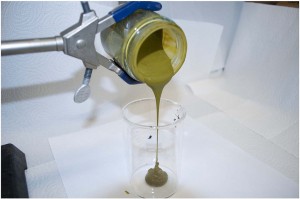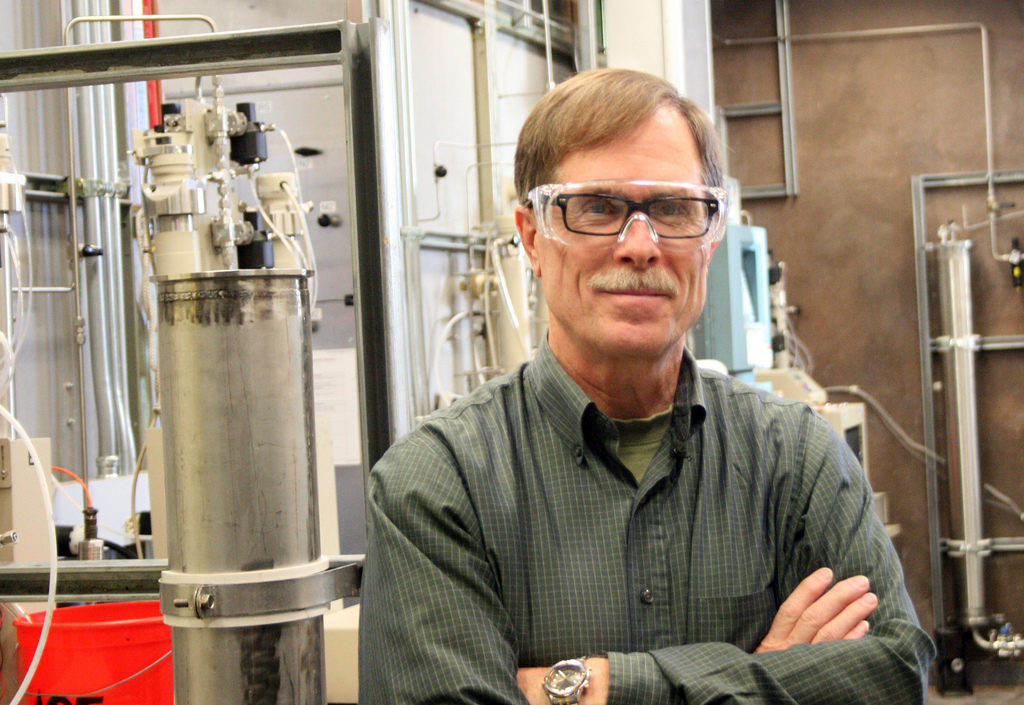RICHLAND, Wash. – Engineers have created a continuous chemical process that produces useful crude oil minutes after they pour in harvested algae — a verdant green paste with the consistency of pea soup.
The research, by engineers at the Department of Energy’s Pacific Northwest National Laboratory, was reported in the journal Algal Research. Utah-based Genifuel Corp., a biofuels company, licensed the technology and is working with an industrial partner to build a pilot plant using the technology.
Making crude from algae
 In the process, a slurry of wet algae is pumped into the front end of a chemical reactor. Once the system is up and running, crude oil in less than an hour, along with water and a byproduct stream of material containing phosphorus that can be recycled to grow more algae.
In the process, a slurry of wet algae is pumped into the front end of a chemical reactor. Once the system is up and running, crude oil in less than an hour, along with water and a byproduct stream of material containing phosphorus that can be recycled to grow more algae.
With additional conventional refining, the crude algae oil is can be converted into aviation fuel, gasoline or diesel fuel. The waste water is processed further, yielding burnable gas and substances like potassium and nitrogen, which, along with the cleansed water, can also be recycled to grow more algae.
Algae as fuel
While algae has long been considered a potential source of biofuel, the fuel is projected to be expensive. The PNNL technology harnesses algae’s energy potential and incorporates methods to reduce the cost of producing algae fuel.

“Cost is the big roadblock for algae-based fuel,” said Douglas Elliott, the laboratory fellow who led the PNNL team’s research. “We believe that the process we’ve created will help make algae biofuels much more economical.”
Streamlining the process
PNNL scientists and engineers simplified the production of crude oil from algae by combining several chemical steps into one continuous process. The most important cost-saving step is that the process works with wet algae. Most current processes require the algae to be dried — a process that takes a lot of energy and is expensive. The new process works with an algae slurry that contains as much as 80 to 90 percent water.
“Not having to dry the algae is a big win in this process; that cuts the cost a great deal,” said Elliott.
While a few other groups have tested similar processes to create biofuel from wet algae, most of that work is done one batch at a time. The PNNL system runs continuously, processing about 1.5 liters of algae slurry in the research reactor per hour. Though that doesn’t seem like much, it’s much closer to the type of continuous system required for large-scale commercial production.
The products of the process include:
- Crude oil, which can be converted to aviation fuel, gasoline or diesel fuel. In the team’s experiments, generally more than 50 percent of the algae’s carbon is converted to energy in crude oil — sometimes as much as 70 percent.
- Clean water, which can be re-used to grow more algae.
- Fuel gas, which can be burned to make electricity or cleaned to make natural gas for vehicle fuel in the form of compressed natural gas.
- Nutrients such as nitrogen, phosphorus, and potassium — the key nutrients for growing algae.
The recent work is part of DOE’s National Alliance for Advanced Biofuels & Bioproducts, or NAABB. This project was funded with American Recovery and Reinvestment Act funds by DOE’s Office of Energy Efficiency and Renewable Energy. Both PNNL and Genifuel have been partners in the NAABB program.
In addition to Elliott, authors of the paper include Todd R. Hart, Andrew J. Schmidt, Gary G. Neuenschwander, Leslie J. Rotness, Mariefel V. Olarte, Alan H. Zacher, Karl O. Albrecht, Richard T. Hallen and Johnathan E. Holladay, all at PNNL.
STAY INFORMED. SIGN UP!
Up-to-date agriculture news in your inbox!











